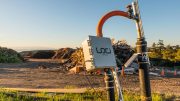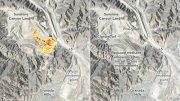
Cities are a significant contributor to global methane emissions caused by human activities, but most cities lack complete information about the sources of this greenhouse gas. A team led by McGill University measured methane emissions in Montreal and found that two major sources of emissions in the city, historic landfills and manholes, were not included in the city’s inventory of greenhouse gas emissions.
Montreal’s municipal greenhouse gas inventory presents an incomplete picture of methane emissions.
Cities are responsible for almost 1/5th of the global methane emissions caused by human activities. However, most cities don’t capture information about the full range of sources of this powerful greenhouse gas. In 2020, a team led by McGill University, measured methane emissions from various sources across the city of Montreal. The researchers found that two of the four most important sources of methane emissions in the city (historic landfills and manholes) are not included in the city’s municipal greenhouse gas inventories, making it difficult to tackle the problem fully, or reach the city’s goal of being carbon neutral by 2050.
The study provides the first set of direct measurements of methane emissions in Montreal and in the province of Quebec.
The study provides detailed and specific measurements of methane emissions by source – such as the type of manhole or the type of natural gas infrastructure. The results, which highlight the importance of gathering information about the specific sources of methane emissions to set in place mitigation strategies that are adapted to each specific situation should be of interest not only to researchers across Canada and around the world but also to policymakers.
“Cities are uniquely positioned to mitigate methane emissions as they face fewer political challenges than larger bodies such as provinces, states, territories, or countries,” says Mary Kang, an assistant professor in McGill’s Department of Civil Engineering and the senior author on the paper published recently in Environmental Science and Technology. “However, municipal greenhouse gas inventories often underestimate emissions and tend to be based on few measurements made elsewhere, making it difficult to develop actionable mitigation strategies.”
Crucial details about sources of emissions pave way for informed decisions
To provide the city with actionable mitigation strategies, the team measured methane emissions from over 600 different sources across the city, covering historic landfills and manholes (the second and third largest sources of methane emissions, respectively) as well as leaks from natural gas distribution.
“Making choices about how to reduce methane emissions in an efficient and cost-effective way will involve balancing various considerations, depending on the source of the emissions,” explains James Williams, the PhD student who is the first author on the paper. “For instance, historic landfills have the potential for the greatest reduction in the volume of methane emissions but will involve the highest mitigation costs unless the choice is made to focus on simply the highest emitting landfills. For emissions from natural gas leaks, increasing repair rates of high-emitting industrial meters could greatly reduce mitigation costs and emissions. But doing the same thing when it comes to residential meters would lead to smaller reductions at a much higher cost.”
To get the full picture of how methane emissions can be reduced, the researchers plan to take additional measurements from all methane sources around the city to ensure that they aren’t missing the highest emitters. They also plan to look at methane emissions from sources such as urban waterways and canals.
Reference: “Differentiating and mitigating methane emissions from fugitive leaks from natural gas distribution, historic landfills, and manholes in Montreal, Canada” by James P. Williams, Sebastien Ars, Felix Vogel, Amara Regehr and Mary Kang, 14 November 2022, Environmental Science and Technology.
DOI: 10.1021/acs.est.2c06254









“Cities are responsible for almost 1/5th of the global methane emissions caused by human activities.”
The role of methane — both anthropogenic AND natural — is exaggerated. The atmospheric concentration of CO2, as measured at MLO, is about 420ppm and is increasing about 2.5ppm annually. Methane has a concentration of about 1.9ppm and is increasing about 0.009PPM annually. The human contribution to the annual increase is a fraction of the total, probably less than one-half. Yes, short-term, methane has more potential for warming than CO2, but it is effectively gone in a decade, having a long-term impact that is only about 25X that of CO2. With CO2 being 200-300X as abundant, even with the greater impact of methane, anything that we can do to reduce methane will have negligible impact — especially when there are activists trying to re-introduce beavers to the Western US and the UK. Beavers create wetlands, which are a major ‘natural’ source of methane. It seems that the left-hand often doesn’t know what the right-hand is doing.